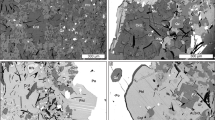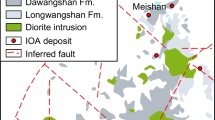Abstract
Studies of fossil bacteria show that mineral formation affected by or involving bacteria has occurred everywhere on Earth since the emergence of bacteria. Homogeneity of rocks and rock formations in the Precambrian and Devonian indicate that similar conditions in the Archean, Proterozoic, and Devonian, during the formation of the rocks studied.













Similar content being viewed by others
Notes
Greenstone belts are among the structural elements of the ancient continental platform. They are complexes of ultramafic and mafic igneous rocks, volcanic-sedimentary formations, and granite intrusive rocks. They are deposited as thick (up to 20 km) linear strata (belts), which are up to 1000 km long and 200 km wide. Greenstone belts are the most common Middle and Late Archean rock complexes. The age of the greenstone belts is 2.5–3.5 Ga.
REFERENCES
Antoshkina, A.I., Bacterial rock formation: The reality of modern research methods, Uchen. Zap. Kazan. Univ., Ser. Estestv. Nauki, 2011, vol. 153, no. 4, pp. 114–126.
Astafieva, M.M. and Zaitseva, L.V., Bacterial-paleontological study of siderite transformation in the Early Proterozoic jaspilites of the Kursk magnetic anomaly, Paleontol. J., 2020, vol. 54, no. 8, pp. 922–929.
Astafieva, M.M., Felitsyn, S.B., and Alfimova, N.A., Bacterial paleontology of the Neoarchean banded iron formations of Karelia and the Kola Peninsula, Paleontol. J., 2017, vol. 51, no. 4, pp. 430–440.
Bakterial’naya paleontologiya (Bacterial Paleontology), Rozanov, A.Yu., Ed., Moscow: Paleontol. Inst. Ross. Akad. Nauk, 2002.
Belova, M.Y. and Akhmedov, A.M., Petsamomyces, a new genus of organic-walled microfossils from the coal-bearing deposits of the Early Proterozoic, Kola Peninsula. Paleontol. J., 2006, vol. 40, no. 5, pp. 465–475.
Brusnitsyn, A.I., Perova, E.N., Vereshchagin, O.S., Britvin, S.N., Letnikova, E.F., Shkolnik, S.I., and Ivanov, A.V., Barite–lead–zinc and iron–manganese deposits of the Zhairem ore district: A geological field trip to Central Kazakhstan, Mineralogy, 2018, vol. 4, no. 3, pp. 82–92.
Brusnitsyn, A.I., Perova, E.N., Vereshchagin, O.S., Letnikova, E.F., Shkolnik, S.I., and Ivanov, A.V., Stratiform Lead-Zinc, Barite and Iron-Manganese Ores of the Zhayremsky Ore Cluster (Central Kazakhstan): Conditions of Occurrence, Composition, Genesis, Metallogeny of Ancient and Modern Oceans. Differentiation and Reasons for the Diversity of Ore Deposits, Miass: IMIN UB RAS, 2017, pp. 90–94.
Buick, R., Ancient acritarchs, Nature, 2010, vol. 463, pp. 885–886.
Cloud, P.E., Jr., Atmospheric and hydrospheric evolution on the primitive Earth, Science, 1968, vol. 160, no. 3829, pp. 729–736.
Costerton, J.W., Geesey, G.G., and Cheng, K.J., How bacteria stick, Sci. Am., 1978, vol. 238, no. 1, pp. 86–95.
Dodd, M. and Papineau, D., Biosignatures of early life in >3.8 Ga Banded Iron Formations?, Geophys. Res. Abstr., 2015, vol. 17, EGU2015-12987-1.
Iskopaemye bakterii i drugie mikroorganizmy v zemnykh porodakh i astromaterialakh (Fossil Bacteria and Other Microorganisms in Terrestrial Rocks and Astromaterials), Rozanov, A.Yu. and Ushatinskaya, G.T., Eds., Moscow: Paleontol. Inst. Ross. Akad. Nauk, 2011.
Kholodov, V.N., Evolution of Sedimentary Process in the Earth’s History, Problemy doantropogennoi evolyutsii biosfery (Problems of Pre-Anthropogenic Evolution of Biosphere), Rozanov, A.Yu., Ed., Moscow: Nauka, 1993, pp. 123–167.
Klein, C., Some Precambrian banded iron formations (BIFs) from around the world: Their age, geologic setting, mineralogy, metamorphism, geochemistry, and origin, Am. Miner., 2005, vol. 90, no. 10, pp. 1473–1499.
LaBerge, G.L., Microfossils and Precambrian iron formations, Geol. Soc. Am. Bull., 1967, vol. 78, no. 2, pp. 331–142.
LaBerge, G.L., Possible biological origin of Precambrian iron-formations, Econ. Geol., 1973, vol. 68, no. 7, pp. 1098–1109.
Mitryaeva, N.M., Mineralogiya barito-tsinkovo-svintsovykh rud mestorozhdenii Atasuiskogo raiona (Mineralogy of barite-zinc-lead ores of Atasuysk district), Alma-Ata: Nauka, 1979.
Nikolaev, Yu.A. and Plakunov, V.K., Biofilm—“city of microbes” or an analogue of multicellular organisms?, Microbiology, 2007, vol. 76, no. 2, pp. 125–138.
Posth, N.R., Konhauser, K.O., and Kappler, A., Banded iron formations, Encyclopedia of Geobiology, Reitner, J. and Thiel, V., Eds., Dordrecht, The Netherlands: Springer, 2011, pp. 92–103.
Rosen, O.M., Abbyasov, A.A., Aksamentova, N.V., Bredanova, N.V., Zlobin, V.L., Migdisov, A.A., Safronov, V.T., Tolkachikova, A.A., Trusov, A.I., Chekhovich, P.A., and Yaroshevsky A.A., Sedimentatsiya v rannem dokembrii: tipy osadkov, metamorfizovannye osadochnye basseiny, evolyutsiya terrigennykh otlozhenii (Early Precambrian Sedimentation: Sedimentary Types, Metamorphic Sedimentary Basins, and Evolution of Terrigenous Deposits), Moscow: Nauchnyi Mir, 2006.
Rozanov, A.Yu., Conditions of life on the early Earth after 4.0 Ga, Problemy proiskhozhdeniya zhizni (Problems of the Origin of Life), Moscow: Paleontol. Inst. Ross. Akad. Nauk, 2009, pp. 185–201.
Rozanov, A.Yu. and Astafieva, M.M., Prasinophyceae (Green Algae) from the Lower Proterozoic of the Kola Peninsula, Paleontol. J., 2008, vol. 42, no. 4, pp. 90–93.
Rozanov, A.Yu. and Astafieva, M.M., Archean eukaryotes: a new outlook, Paleontol. J., 2020, vol. 54, no. 1, pp. 1–5.
Rozanov, A.Yu., Astafieva, M.M., Zaitseva, L.V., Alfimova, N.A., and Felitsyn, S.B. Cyanobacteria(?) in iron banded formations of the Kursk magnetic anomaly, Dokl. Biol. Sci., 2016, vol. 470, pp. 231–233.
Rozhnov, A.A., Comparative Characteristics of Manganese Deposits of the Atasuy and Nikopol-Chiatura Types, Geologiya i geokhimiya margantsa (Geology and Geochemistry of Manganese), Moscow: Nauka, 1982. Earth’s Earliest Biosphere, its Origin and Evolution, Schopf, J.W., Ed., Princeton N.J.: Princeton Univ. Press, 1983.
Skripchenko, N.S., Gidrotermal’no-osadochnye polimetallicheskie rudy izvestkovo-slantsevykh formatsii (Hydrothermal-Sedimentary Polymetallic Ores of Limeshale Formations), Moscow: Nedra, 1980.
Skripchenko, N.S., Prognozirovanie mestorozhdenii tsvetnykh metallov v osadochnykh porodakh (Prediction of Nonferrous Metal Deposits in Sedimentary Rocks), Moscow: Nedra, 1989.
Slobodkin, A.I., Thermophilic iron-reducing prokaryotes, Extended Abstract of Doctoral (Biol.) Dissertation, Moscow: Winogradsky Inst. Microbiol., Russ. Acad. Sci., 2008.
Varentsov, I.M., Weimarn, A.B., Rozhnov, A.A., Shibrik, V.I., and Soklova, A.L., Geochemical model of formation of manganese ores of the Famennian riftogenic basin of Kazakhstan (main components, rare earths, and trace elements), Litol. Polezn. Iskop., 1993, no. 3, pp. 56–79.
Vologdin, A.G., Zemlya i zhizn’. Evolyutsiya sredy i zhizni na Zemle (Earth and Life: Evolution of the Environment and Life on the Earth), Moscow: Nedra, 1976.
Windley, B.F., The Evolving Continents, Chichester: J. Wiley and Sons, 1999.
Zavarzin, G.A., Development of Microbial Communities in the History of the Earth, Problemy doantropogennoi evolyutsii biosfery (Problems of the Pre-Anthropogenic Evolution of the Biosphere), Rozanov, A.Yu., Ed., Moscow: Nauka, 1993, pp. 212–222.
Zavarzin, G.A., The change of the paradigm in biology, Vestn. Ross. Akad. Nauk, 1995, vol. 65, no. 1, pp. 8–23.
Zavarzina, D.G., The role of dissimilatory Fe(III)-reducing bacteria in transformation of iron minerals, Paleontol. J., 2004a, vol. 38, no. 3, pp. 231–237.
Zavarzina, D.G., Formation of magnetite and siderite by thermophilic Fe(III)-reducing bacteria, Paleontol. J., 2004b, vol. 38, no. 6, pp. 585–589.
ACKNOWLEDGMENTS
The author thanks A.Yu. Rozanov, E.A. Zhegallo, L.V. Zaitseva, and G.T. Ushatinskaya, as well as everyone who helped carry out this research and participated in the discussion of results. The author is especially grateful to A.V. Tkachev, S.B. Felitsyn, and N.A. Alfimova, as well as the TsNIGR Museum team, who kindly provided the samples of the Zhairem jaspiloids and Archean-Proterozoic BIFs for this study.
Author information
Authors and Affiliations
Corresponding author
Additional information
Translated by A. Panyushkina
Rights and permissions
About this article
Cite this article
Astafieva, M.M. Banded Iron Formations (Jaspilites): The Paleontologist’s View. Paleontol. J. 55, 343–354 (2021). https://doi.org/10.1134/S0031030121030060
Received:
Revised:
Accepted:
Published:
Issue Date:
DOI: https://doi.org/10.1134/S0031030121030060




